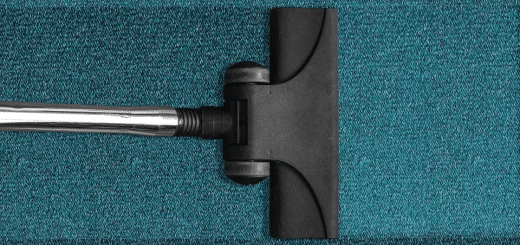How to Clean and Disinfect Gyms and Fitness Facilities
Workout machines and free weights in gyms are covered in bacteria, fungiFungi are a group of organisms, including mold, mildew, and ... More, and virusesViruses are microscopic infectious agents that can only repr... More. Especially in the age of Covid-19, it is critical that facility managers clean and disinfect their gyms or fitness facilities properly to curtail the spread of infectious respiratory illnesses and other ailments.
Gym equipment and surfaces are handled by several people over the course of each day. Consequently, these surfaces become contaminated with high levels of bacteria and virusesViruses are microscopic infectious agents that can only repr... More. The gym floor, too, can potentially harbor a worrisome level of contaminationContamination is the presence of harmful or unwanted substan... More, making frequent disinfection necessary.
What germs flourish in gyms?
Escherichia Coli, known as E. Coli, can be caught from tainted gym surfaces. Shared exercise equipment can also spread staph infections. Candida is a fungus that gym users’ feet can pick up from moist environments, like locker rooms, showers, and saunas.
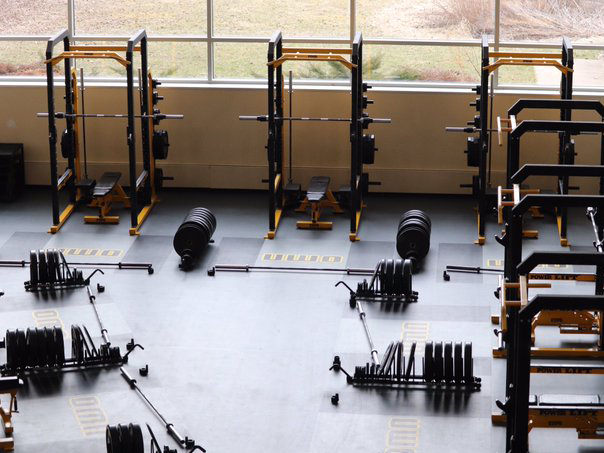
Fitness equipment
Gym goers are susceptible to strep throat when they handle gym doorknobs in the locker room or sweaty exercise equipment. Inhaling infectious respiratory droplets from someone’s sneeze, speech or cough can leadLead is a heavy metal that can be toxic to humans, especiall... More to influenza, or, even worse, the coronavirus disease.
Most of the ailments caused by these germs and virusesViruses are microscopic infectious agents that can only repr... More can be treated with over-the-counter medications, antibiotic tablets, and creams or, in more serious cases, hospitalization. But cleaning and disinfecting the fitness facilities often can help prevent these conditions and protect gym users.
What is the difference between cleaning and disinfecting?
The first step in maintaining a clean and hygienic fitness facility is to understand the difference between cleaning and disinfecting. The two tasks have unique purposes. Both cleaning and disinfecting are necessary to reduce the amount of dirt, grime, bacteria, and germs in the gym.
Cleaning is a first step, whereby germs, impurities and dirt are removed from exercise equipment and surfaces. A solutionA solution is a homogeneous mixture of two or more substance... More of detergent and water may be used to physically wipe away the germs from surfaces. Cleaning does not kill germs but lowers their numbers and the risk of spreading infectionInfection is the invasion and multiplication of harmful micr... More.
Once cleaning is done, disinfecting the gym surfaces should be the next step. The chemicals in disinfectantA disinfectant is a chemical substance used to kill or inact... More products kill the germs and virusesViruses are microscopic infectious agents that can only repr... More on objects, but do not remove dirt or grime. Combining cleaning and disinfecting greatly reduces the risk of spreading infectionInfection is the invasion and multiplication of harmful micr... More.
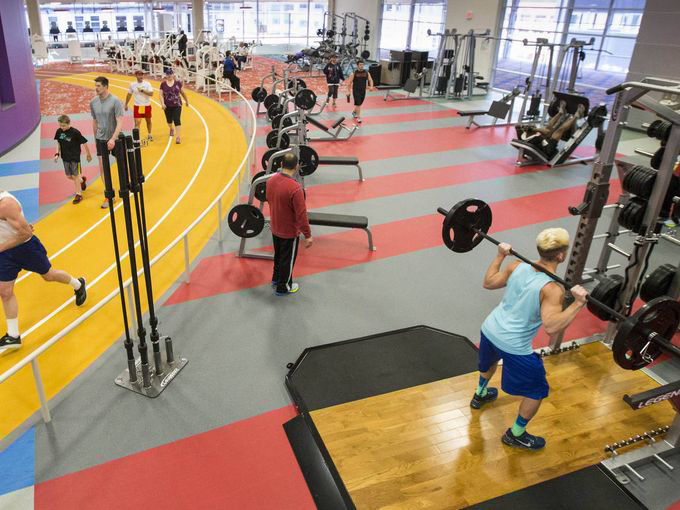
YMCA health club
Since most fitness facility surfaces are nonporous (meaning they do not absorb liquid), they can be disinfected. Examples of nonporous surfaces include glass, plastic, glazed tiles, marble, and metal. Disinfection, as opposed to sanitization, is the preferred method for keeping gyms clean.
What cleaning and disinfectantA disinfectant is a chemical substance used to kill or inact... More products are best?
In order to eliminate germs and virusesViruses are microscopic infectious agents that can only repr... More from gym equipment and other surfaces, it is important to use the right disinfectants. Each disinfectantA disinfectant is a chemical substance used to kill or inact... More product specifies a contact time (how long the product remains visibly wet on the surface). Following the product directions is key to killing virusesViruses are microscopic infectious agents that can only repr... More and bacteria.
EPA-approved disinfectants should be used. Lysol Disinfecting Wipes and Lysol Brand All-Purpose Cleaner, for instance, kill SARS-CoV-2, the virus that causes Covid-19. The Clorox Company also produces several disinfectants that are effective against a range of virusesViruses are microscopic infectious agents that can only repr... More, including the coronavirus.
How do cleaning personnel protect themselves?
Handling potentially contaminated surfaces is a serious danger in itself. Exposure to virusesViruses are microscopic infectious agents that can only repr... More and bacteria can leadLead is a heavy metal that can be toxic to humans, especiall... More to illness. Cleaning staff are urged to fully protect themselves by wearing personal protective equipment (PPE)Personal protection equipment (PPE) is safety gear such as g... More while cleaning and disinfecting the fitness facility.
Appropriate PPE includes gloves and a mask—at a minimum. Cleaning personnel may also wear a face shield, gown, and eye protection (such as goggles) to protect from inadvertent splashes. Proper disposal of the PPE after cleaning is necessary to limit the spread of germs and virusesViruses are microscopic infectious agents that can only repr... More.
What surfaces should be cleaned and disinfected?
Wiping down workout equipment with an EPA-approved disinfectantA disinfectant is a chemical substance used to kill or inact... More should be a priority. Other nonporous gym surfaces should also be cleaned and disinfected. High-touch objects inside a fitness facility that require daily attention include countertops, light switches, faucet handles and doorknobs.
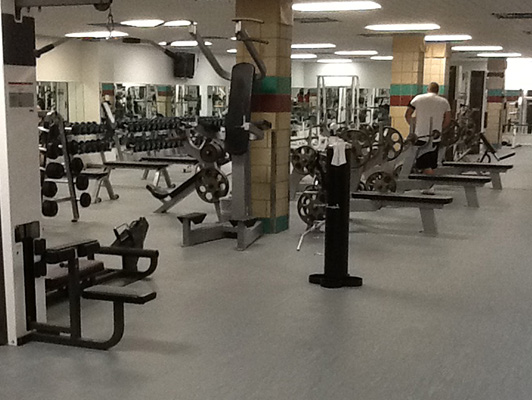
Fitness center
When using disinfecting wipes, staff should wipe in one direction to prevent recontamination of the surface. Simply spray surfaces when using sprays. After disinfecting, consider flushing the equipment with soap and water to remove the dried disinfectantA disinfectant is a chemical substance used to kill or inact... More, which can irritate some gym users’ skin.
Should a cleaning schedule be implemented?
Routine cleaningRoutine cleaning is the regular cleaning performed to mainta... More and disinfecting will limit the spread of harmful germs. Facility managers are advised to prepare a daily cleaning schedule to which the staff may adhere. Daily cleanings should also be documented or logged to ensure the facility undergoes cleaning and disinfecting regularly.
In fact, since multiple people use the various gym equipment throughout each day, several cleanings per day are necessary to maintain a hygienic facility. Shared portable equipment, such as a foam roller or stability ball, should be disinfected several times per day.
How can facility managers educate gym users?
Gym goers can limit exposure to germs while inside the facility by following three steps: Upon use, cover the equipment with a towel, which serves as a barrier between the machine and skin; use a disinfectantA disinfectant is a chemical substance used to kill or inact... More wipe to clean each machine after use; lastly, wash hands after the workout.
In the coronavirus era, fitness facilities should be cleaned and disinfected frequently to limit the spread of virusesViruses are microscopic infectious agents that can only repr... More. In addition to regular cleaning and disinfecting to protect gym users, facility managers should consider investing in gym floors that feature antibacterial properties.
Gym and Fitness Flooring
Kiefer USA offers a wide range of exercise flooring designed to meet the rigorous demands of clients in a gym or fitness facility. Our Mondo Sport Impact and Mondo Ramflex floors are nonporous, antibacterial and do not require coatings—making them an ideal choice for today’s fitness needs.
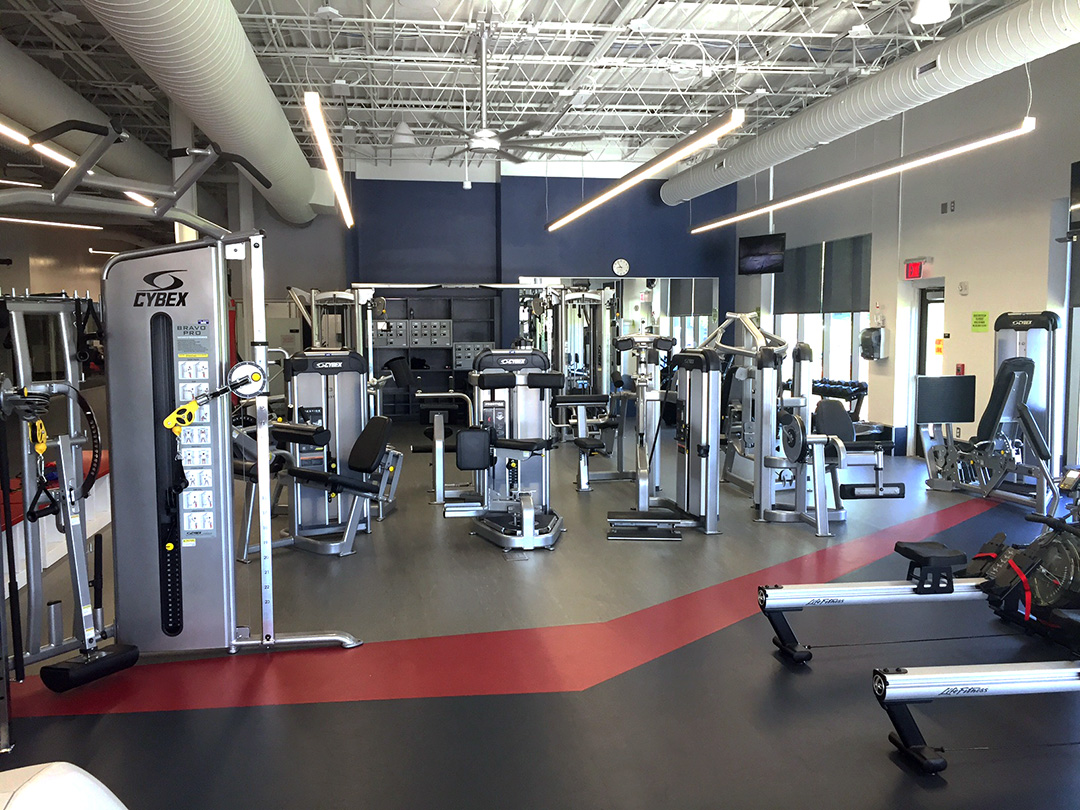
Weight room
Our workout room flooring choices also include FitZone Free Weight, which features interlocking tiles and resistance to marks or impacts. Kiefer USAs FitZone Multi has a cushion layer, and our Tuff-Roll & Tuff-Lock is extremely durable under the heaviness of free weights.
Kiefer USA has fitted various fitness facilities, from Four Seasons Health Club to Beacon Health and Fitness, with premium exercise flooring. We are ready to help you revamp your fitness facility. Call one of our friendly representatives when you aim to take your gym floors to the next level.












